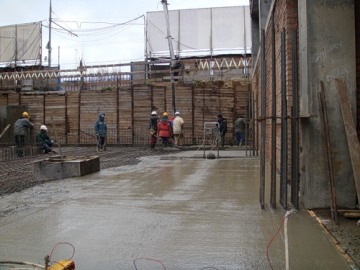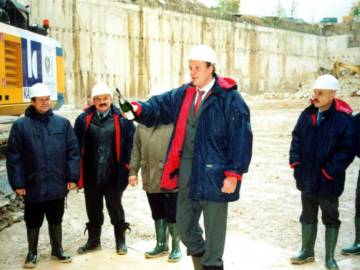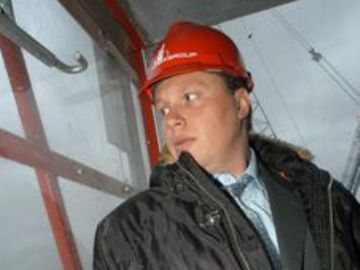Attached dossier
Oligarch Sergei Polonsky has never completed a development project without cheating his partners or having found himself in the middle of the scandal. Polonsky cynically manipulates facts, lying all the time and advertising the developments he is unable to complete. After scrutinizing Polonsky’s building projects one comes to the only conclusion possible: dealing with him should be strictly avoided. Private investors in his housing projects have little chances to move into their flats or to see their investment back.
Well House Dubrovka Residential Complex
The Well House Dubrovka is a housing complex, which consists of two 18-29 storey tall building perched on a two-storey podium in the heart of Moscow’s Dubrovka neighbourhood. Buildings has modern style façade - bright, dynamic, yet somewhat austere. The infrastructure of the complex includes public services, super market, trade and leisure centre, café, and swimming pool. The Well Houses should comprise almost 200,000 square metres of flats. The budget is over $350 million.
This housing project presented a problem even for a person like Polonsky. His attempts to jettison the project faced unexpectedly active and organize counteraction of the tenants-to-be, who realised they were being deceived.
Defrauded investors formed non-profit partnership For the Rights of the Shareholders of Well House Dubrovka, which grew into building-and-housing cooperative Dubrovaka Neighbourhood NP. Members of the co-op are struggling for recognition their property rights. Before the co-op got the state registration in September 2011, its members went through fire and water, due to business activity of Sergei Polonsky, or better to say his inability to run the project.
The situation, surrounding Well House Dubrovka, affected everyone in Moscow’s building industry. Dishonesty of Mirax Group infringed damages on more than 500 families, that is a few thousand people. Sergei Polonsky undertook to save the project, however all his actions appeared to be aimed at triggering public backlash against him.

A year after the building works were abandoned, Mirax Group came up with the “fantastic” idea. They found a new co-investor, Pyatigorsk-based Universal Company. The authorized capital of the company was 29,000 roubles (less than $1,000) and it had never run a building project in Moscow, which raised suspicion that the company was a front organization for siphoning off the cash of the potential investors.
The investment scheme was also suspicious. Universal Company planned to invest 1.5 billion roubles ($50 million), which would enable Mirax Group resume construction works and, under that pretext, carry on selling the flats in the unfinished complex. It was proposed, that Universal Company get the money which Mirax Group receives from selling the flats. Of cause, Universal Company could dissapper any moment, having plundered the buyer of the flats, but such details was not made public.
Vladimir Zhossan, who represents the shareholders, said, “We believe that it is a front company that came in not to complete the building but rather to canalize the public outrage and the reaction of the authorities”.
Luckily for the shareholders, Univeral Company pulled out as unexpectedly as it cropped up. Well House Dubrovka was abandoned until the beginning of 2011, when the building works continued, although very slowly.
In spring 2011 the tenants-to-be were shocked by the news of Sergei Polonsky’s plans to take out a loan “against his large business projects”, including the residential complex in Dubrovka. People got scared that they would never see their flats, because Polonsky is not used to pay off his debts in time and their property would go to the creditors. They called for journalists and Moscow’s mayor Sergei Sobyanin to interfere and force Polonsky to pull out of the construction works.
“Either Polonsky is totally nuts, or he is a con artist,” they said.
It emerged in April 2011 that it is not far from true. Instead of resuming the building works, Sergei Polonsky wasted time in negotiations with Moscow authorities over the number of municipal flats in the complex. The negotiations dragged on until the building permission of Mirax Group expired.
When the investors were fed up with Polonsky’s tricks, they brought the case before the court. In September 2011 the Arbitration Court began hearing the case against Nazvanie.Net, Mirax Group successor. The investors of Well House Dubrovksa asked the court to recognize their ownership of the flats they paid for. The trial continues.
Literaturnaya Gazeta Residential Complex
The project of luxurious housing, comprising 30,000 square metres of flats in the historic buiding of the editorial of Literaturnaya Gazeta in Kostaynsky Pereulok Street in cenral Moscow, was worth $190m dollars. Low budget for ambitious Polonsky.
The further information about the project is unavailible. It is evident that Literaturnaya Gazeta remained a paper development, however there were reports that Mirax Group attracted capital from individual investors. It is difficult to say what happened with their money.
There is another aspect of Literaturnaya Gazeta project that should be emphasized. The project exemplifies the way Polonsky treats his business partners and other people, as well.

At the beginning Literaturnaya Gazeta was a joint venture of Mirax and another Moscow’s development company Sistema Gals, part of Sistema Group. Kostyansky 13 Closed JSC ran the development. Sistema and Mirax each owned 50% of the shares in it.
By the end 2007, the management of Sistema understood that it was not reasonable to continue the joint venture with Polonsky. The sides agreed that Sistema would sell its share in Literaturnaya Gazeta to Mirax. Under the $22 million deal, Mirax had to make payment to Sistema in three tranches.
When Sistema transferred its 50% in Kostyansky 13, having met its commitments, it emerged that Polonsky’s Mirax paid only the first tranche of $1.2 million. After that the company stopped paying. No surprise, one could say. Mirax had absolutely no reasons for non-paying, but nevertheless it did not pay, and that was it. Sistema Gals sent a memorandum to Mirax, asking why it had not met its engagements under the agreement. Mirax did not reply, and Sistema went to the law. It submitted 300 million roubles ($10m) lawsuit against Mirax.
The story leaked to the media, and Polonsky had to make up an exuse. He said that he had been unaware of the deal, and learned about the problem from the newspapers.
The information which Serhei Polonsky received from the newspapers did not encourage him into carrying out his obligations, though. He did the opposite thing. Instead of simply paying off the rest of the money, he submitted a counter-claim against Sistema. Mirax Group asked judges to invalidate the purchase agreement signed between the companies on the grounds that there was a “considerable change in circumstances”, that is the ban of Moscow’s authorities to build multi-functional residential complexes in the centre of Moscow. Mirax failed to prove the court that this ban could influence the necessity to fulfil its commitments under the purchase agreement.
The court ruled in favour of Sistema. The case unmasked Polonsky’s readiness to con his business partners out of money and showed him caring two hoots about business commitments.
Everything turned out happily for Sergei Polonsky, though. Sistma sold its rights to redeem the debt of Mirax Group to the third party. The management of Sistema might have been dreaming about getting rid of Polonsky and his tricks. The company that bought the rights owed to Mirax Group itself, and with the offsetting debts the dispute finally was resolved in the end of 2009.
Despite abandonment of Literaturnaya Gazeta project, Sergei Polonsky did not see anything wrong in trying to put it in pledge, along with other development projects, for the holders of Mirax Group bonds. The company raised almost $400 million by issuing the bonds, which is now its public debt.
The story of paper project called Literaturnaya Gazeta is an example of the fact that Polonsky has no principles whatsoever when it comes to other people’s money. Let the investors in other projects of Mirax Group learn from the story!
Poklonka Parkline Residential Complex
It is a highly advertised and ambitious project of Sergei Polonsky. Below you can read the advertisement, dated 2008.
“For the first time in the world’s history the project of that scale is being implemented: within just 10 years the picturesque boulevard with the multi-functional residential super-complex will appear on the site of a faceless railroad. It will be the island of the future life. For the first time in the world’s history Mirax Group implements 650,000 square metre development suspended above the railroad. The development implies building an area of land suspended above Kiev-Moscow railroad. We will develop this area, along with the adjacent territory”.

“Super-complex” was supposed to have underground highway, alternate to Kutuzovsky highway, underground parking space, offices, trade centres and housing. In short, it was a dream project with 2 million square metres of flats and the budget of almost $6 billion.
For Poklonka Parkline Mirax Group was awarded with Grand Prize of Russia’s Building Awards as the best development company of the year.
“This award is an honour. It is also symbolic. Today we are best in Russia, tomorrow we are best in the world”, said Maksim Temnikov. Temnikov is a controversial member of the board of Mirax Group and Polonsky’s confidant.
The best developer in Russia was unable even to begin building its monstrous Poklonka complex. On the contrary, they revealed their excellent advertising skill, if muddling journalists’ brains is what we call advertising. If Mirax deceived professionals in the building industry who judges the Building Awards, how easy it was to cheat inexperienced private investors!
In August 2011 president of state-run Russian Railways Vladimir Yakunin posted the critical message about Sergei Polonsky.
“A businessman that went bankrupt is looking for a scapegoat”.
Sergei Polonsky was hurt by theses words, which are actually true. He promised that he would take the case to the court and make Yakunin apologize for his words.
1, Kremlin Embankment Multipurpose Complex
The project was pompously advertised as that of a Moscow Centre of Small Business and Crafts, comprising more than 20,000 square meters of offices, apartments and luxury dwelling in the Kremlin embankment, between the Kremlin and the Cathedral of Christ the Saviour. Project budget amounted to over $ 200 million. The project included restoration of historic Alyabiev’s house, a Moscow landmark. The project draft had 2012 as year of completion.
The project revealed much of the minor criminal proclivities of Polonsky.
As always, at the start the project seemed wonderful. This project of Sergei Polonsky’s company was first announced as a joint one with a company, controlled by famous businessman Leonid Gandelman, the owner of the retail chain Le Monti. Just like in the case with Literaturnaya Gazeta, Gandelman was not eager to develop a joint business with Polonsky, and therefore his entity legally registered as O. Niks, that was Polonsky’s partner in the project, intended to sell its 25-percent stake to Mirax.

The announcement about the transaction came about in summer 2009, when the crisis had already hit real estate market. However, Maksim Temnikov, Mirax Group board member close to Polonsky, made another bold statements describing the enormousness of the future building. As usual, his statements were only to fill the content of newspapers and in no way corresponded with the actual situation. A year later, at the end of 2010, this project resulted for Mirax Group into another criminal scandal.
Mikhail Dvorkovich, brother of presidential aide and a representative of the company, complained to reporters about law enforcement officers who came to the office of Mirax.
“A few dozen men with assault rifles, in masks and bullet-proof vests forced their way into the reception of the Group management. They demanded us to show them paperwork on some projects of the company ... For example, a contract between Mirax and Moscow city government for the project of the complex in 1, Kremlin Embankment…”
Law enforcement officers were really concerned about this project. Seizure of documents in the office was conducted by officers of the Interior Ministry DEB as part of the criminal investigation into large-scale land fraud involving land plots in the heart of Moscow, namely the Kremlin Embankment, which was opened in October 2010. At that time the main suspect in the case was Stanislav Rubtsov, the director of the Moscow branch of Federal State Unitary Enterprise Rostekhinventarizatsiya Federalnoe BTI. The case is still under investigation, carried out by investigators of the police office for the Central Administrative District of Moscow. According to the police officers, Rubtsov illegally registered a few non-existent real estate objects at the Kremlin embankment. Thus, the police claims, Mirax Group reserved one of the most prestigious land plots of Moscow for future use.
The project has long been frozen, and it seems, the construction was actually never started. Perhaps that is why several thousand people who could have become interest holders in Kremlin Embankment project were incredibly lucky, since if they had signed the contracts, they would have purchased apartments in a building constructed on land acquired by fraud.
Rublyovskaya Riviera Residential Complex
Judging by Mirax advertising, the complex was located in an enclosed, guarded area of 7.3 hectares. The complex had a well-developed infrastructure, including a three-level parking, a daycare, a school, an outpatient hospital, a sports-and-fitness centre with an outdoor swimming pool, a shopping mall, restaurants, a golf club, a maintenance service, and even a nature reserve. The project draft had in it 330,000 square metres of buildings, housing and offices, with a budget of more than half a billion dollars.
Amid the virtual splendour, people interested in purchasing housing in the Rublevskaya Riviera noticed an interesting nuance. They found out that about a hundred metres from the luxury of the future complex, that is in close proximity, there is a small factory, supposedly belonging to Bakulevsky cardiological centre. This little factory manufactures products of great concern when taking into account its close proximity to a residential building. It produces biomedical products with all its consequences, including emission into the atmosphere and pollution of the surrounding soil.
Mirax Group adds, of course, preferred to ignore this nuance, which does not mean that it does not matter to people who may someday live there. However, now it is clear that the happy moment of people moving in to Rublevskaya Riviera is very, very far away. Except that the situation once again highlighted the attitude of Sergei Polonsky and his team to potential investors.
This pretentious, loudly advertised project is distinguished by its exceptional uselessness. The following fact proves it.
In spring 2011, when all Mirax were frozen, Sergei Polonsky tried to get rid of the project and at the same time to get profit. In particular, Mirax discussed assignment of rights for the construction of the residential complex to Oleg Deripaska’s Basic Element. Apparently, this attempt failed since neither party announced successful transaction.
Astra Montenegro hospitality complex
In April 2009 those interested in real estate market became aware of a new bold project of Sergei Polonsky in Montenegro. It included the development of a national government project called Velika Plyaja aimed at building a huge network of hotels with a total capacity of 30 thousand rooms. It was reported that Polonsky purchased 20 hectares of land in the town of Ulitskaya Riviera for the project and was about to acquire another 30 hectares. But Polonsky was not satisfied with just one project, even though it was such a large scale one. He decided to simultaneously take part in the national project to develop the northern territories of Montenegro and bought more than 40 hectares of land for the second project. A network of hotels and chalets at the foot of the mountains was to be built in the northern part of the country.
All of these ambitious undertakings were conducted by Mirax Balkan, which, like Mirax Group, is controlled by Polonsky.
The cynicism of the situation was that at that very time most Russian projects of Mirax were frozen, and both Polonsky and his company were mired in staggering debt. Defrauded real estate investors did not know which strings to pull to make Polonsky do at least partly cover the undertaken obligations.
A public statement by Polonsky was even more of an irony. The businessman claimed that to realize Montenegrin “super projects”, he would not be using Mirax Group assets, because Mirax Balkan was an all-round self-sufficient company. The question on sources of financial independence of the newly established company was, naturally, left with no response. But when discussing the Montenegrin “super projects” of Polonsky, experts mentioned the mysteriously lost money invested by interest holders in Russian projects of Mirax.

Even more outrageous was the fact that when the new pompous project by Mirax Balkan in Montenegro was announced, Mirax Group plunged deeply into debt in the same country and. It happened in the way it usually happened, Mirax Group raised funds from real estate investors in return for promises to build good resort accommodation for them.
The project concerned was Astra Montenegro, in which Mirax Group promissed mainly to Russian investors to build private homes on the Montenegrin resort of Budva. The number of defrauded real estate investors reached 86. Knowing about the Russian adventures of Sergei Polonsky, they created in Montenegro an investment company AMIA, intended for the completion of what they had paid in full to Mirax Group.
The amount of funds missing after the money fell into the hands of Polonsky was impressive. Montenegrin investors had to take a mortgage loan of 180 million euros in order to finish the buildings started by Mirax.
Polonsky reacted to the actions of the real estate investors in his unique style. Muscular men came to AMIA investors in Montenegro. The group of unwelcome visitors was led by Vladimir Golubev, Polonsky’s business partner, known as Barmalei in criminal circles of St. Petersburg. Golubev said that on behalf of Polonsky he was now in charge of the Montenegrin project and demanded all documents on construction set out by AMIA. However, the Montenegro of 2011 was not like the Russia of the early 1990s. AMIA was able to start construction works of houses intended for shareholders deceived by Polonsky.
Montenegrin interest holders wrote a letter to Sergei Polonsky in which, inter alia, there was a question whether the visit of Golubev’s muscular men "to obtain documents and to take control of the situation was part of the project". Naturally, they did not receive a clear answer.
Astra Montenegro of Sergei Polonsky is a clear warning to all real estate investors defrauded by him. It perfectly shows that one cannot believe the promises of this man, for he would say anything just to get your money, then will forward them to Montenegro or anywhere else to set up a new pyramid of construction.
Mirax Park residential complex
The total area of Mirax Park is 150,000 square metres and the entire complex will include 326,000 square metres of premises with a budget of nearly half a billion dollars. Four 34-storey towers will represent the four seasons, which will be done through the colour scheme of lighting and shape of the buildings. In all other aspects the towers would embody a unified architectural concept. Apart from the towers, the complex includes a multisection bloc of varied height, a kindergarten, a school, and other infrastructure units. Residential complex is a convenient high security area. The transport links are located under the ground. There are no cars and roads for motor vehicles near the houses surrounded with paths paved with natural stone and a cultivated park. Underground parking has more than 1,000 parking spots.
This traditionally ambitious project can demonstrate what Mirax shareholders may expect after they receive property right over their apartments, if there was a slight possibility of ever succeeding in that.
Mirax Park is different from the vast majority of other projects by Polonsky in that it actually is partially built. As of April 2011, Mirax Park had 2,000 defrauded real estate investors, which is a small figure for Polonsky. So, while Polonsky was deceiving these people, he tried to convince residents of the already constructed part of Mirax Park to use services of a management company, to which people naturally protested.
Tenants of Mirax Park tried to explain the entrepreneur that it was Mirax Group that the homeowners association had a contract with for the maintenance of the residential complex, and that the homeowners association was not going to change management company. Their motivation was simple. Since it was Polonsky who built the complex, he had committed himself to perform maintenance of what he had built. The homeowners association was literally telling him to be so kind as to meet those obligations. In particular, they asked the developer to do something he was genuinely incapable of, namely to stick to his own promises.

The story can be summarized like this: there are companies that try to earn money by fraud in all circumstances, and one should stay away from these companies. Mirax Group seems to be one of them.
About some projects we could find no information rather than loud advertising typical for Polonsky. Among such projects there is Luzhnetskaya Embankment, a residential complex of 240,000 square meters of apartments, shops, a fitness centre, dry cleaning, laundry, and a two-level underground parking. Announced budget of the project is nearly half a billion dollars. Another such project is Paradise Living, a 51-storey residential complex near the Moscow River with a total area of more than 300 thousand square metres with a budget of almost a billion dollars. No information was also found about Myakinino residential complex advertised to have almost 300 thousand square metres of luxury housing with a stated budget of nearly $ 2 billion. Apparently, these projects have been frozen at some “paper” stage of their existence. So, a few thousand of those interested in luxury dwelling in Moscow were lucky. They did not become defrauded real estate investors of these projects.





